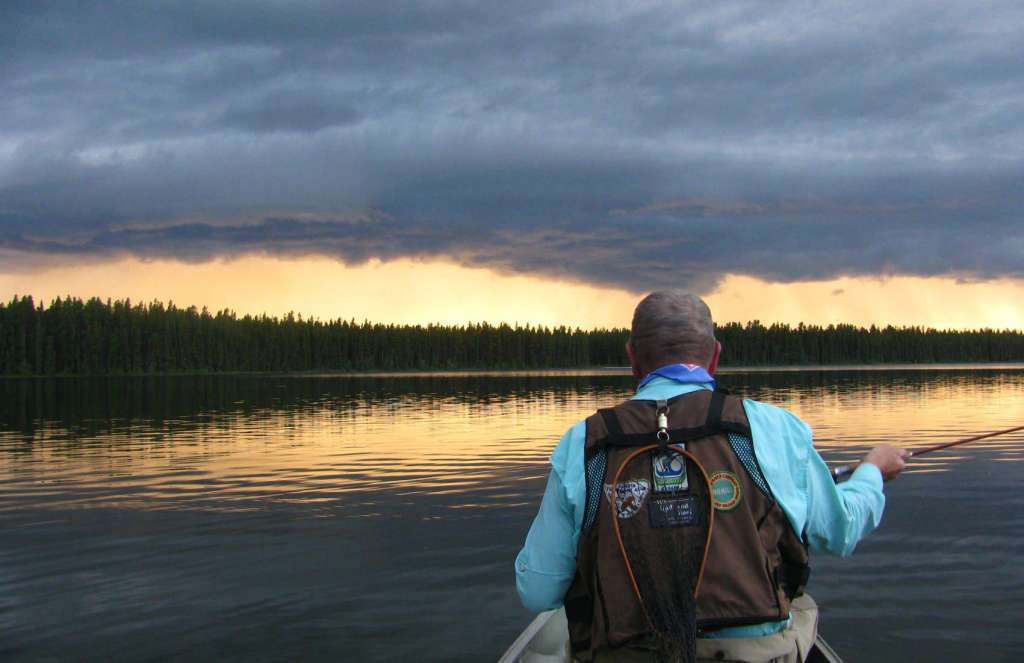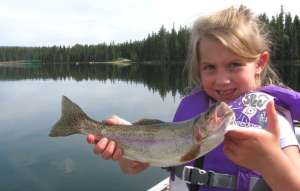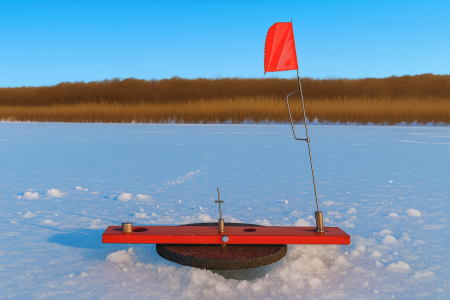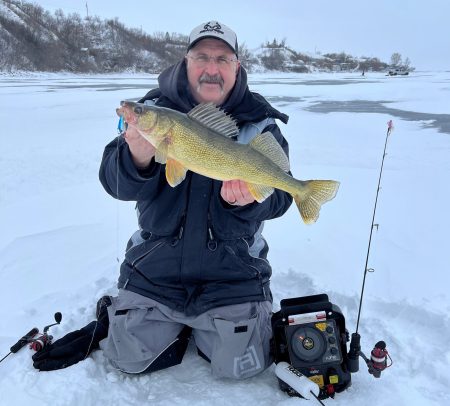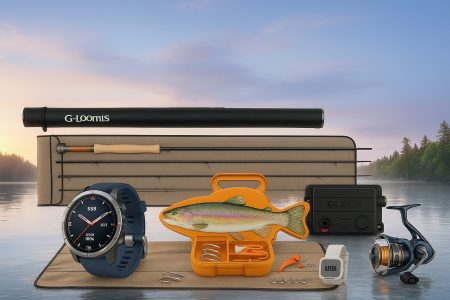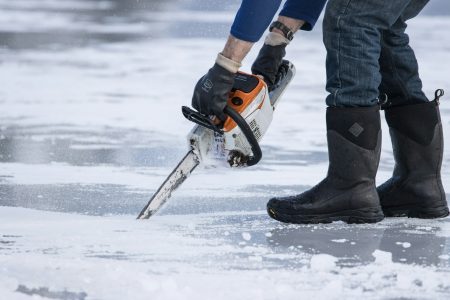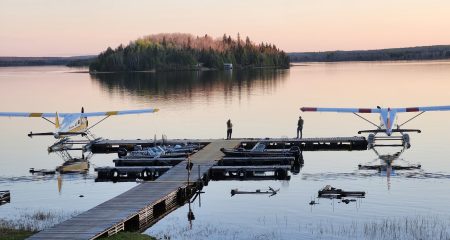When most people think of fly-fishing, they picture a lone angler flinging his arm back and forth in a perfectly synced rhythmic motion, working the candy-cane-shaped line above the water until it reaches the perfect distance to drop and float the fly downstream towards a feeding fish. The visual aspect of watching and waiting for a fish to strike your fly is what makes fly-fishing so appealing and exciting.
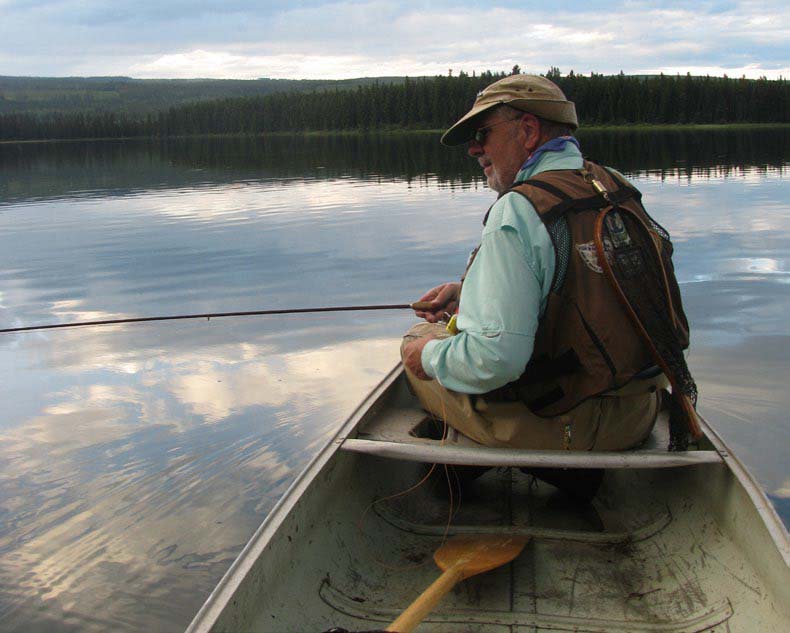
Fly-Fishing Gear for Beginners
The gear required to begin fly-fishing is: rod, reel, fly line, leader and a half-dozen flies. Fishing from shore is tough on many lakes because of the lack of back casting room. Having a boat to get yourself into some deeper water containing structure and for trolling your fly is ideal when starting out on lakes.
Choosing the Right Rod
The rod, although not difficult to find or select, has three properties that will help you narrow down the choice: length, weight and action. Most entry levels rods are made from graphite which is very lightweight and strong and consistently casts your fly with ease. In addition, many manufacturers offer lifetime warranties on ‘beginner’ rods.
Weight
Rod weight refers to the numbering system used with fly line and fly rods and is printed on the butt section just above the handle. One being the lightest and thinnest and twelve being the heaviest and thickest line – you must match the rob number to the line number for optimal performance. Generally speaking, a five to seven weight rod will allow you to fish anywhere in Alberta for all species of fish.
Length
Lengths of fly rods vary from 7 to 10 feet. A general-purpose beginner rod should be around nine feet, which will still seem long for those switching from spinning rods. Fly rods break down into either two to four pieces for easier storage and packing. If you plan to travel into remote backcountry lakes, get a four-piece rod.
Action
Rod action essentially refers to where the rod flexes and is available in slow, medium, or fast. Slow actions feel “whippy”. Fast actions are the stiffest and bend only in the top third of the rod. A beginner should purchase either a medium or fast action rod, as they’ll be more accurate for casting, but if you truly enjoy the feeling of your rod bending in half while fighting a fish of any size, consider a slow action, but be prepared for tougher inaccurate casting, especially on windy days.
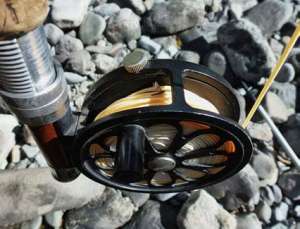
The Reel
Like spin fishing, the reel’s main purpose is to store the line in an organized fashion and force the fish to work harder when trying to escape. Reels are made from many different materials; therefore have a wide variety of costs ranging from $15 – $1000. The other function the reel does is balance the rod, so it’s important to size the reel to match your line/rod weight. Unlike spin fishing, the angler uses their hands to retrieve and shoot line rather than mechanical components and gears found on spinning reels.
Fly Line and Leaders
The line is very important; perhaps the most important part of your gear because it’s responsible for casting your weightless fly out. Fly line can float, sink or just have a sinking tip. As mentioned earlier, fly line is designated by weight and designed to work with the corresponding weight rod and reel. Furthermore, the weight of the line can be stored in a variety of ways: weight forward, tapered or straight. For beginners, purchase a weight forward line as it’ll be the easiest to learn the casting.
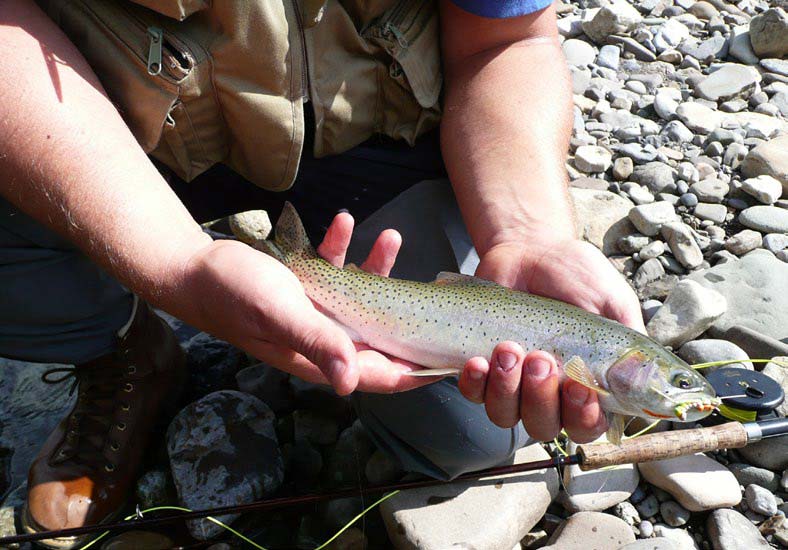
Fly-fishing leaders are made of either near transparent nylon monofilament or fluorocarbon material making your fly appear to be attached to nothing at all in the water. Leader length should equal at least the rod length and be tapered at the end. They are attached to the end of the fly line in one of several different ways but a simple, effective and flexible method is to use a loop-to-loop connection – which allows anglers to change leaders quickly and easily.
Beginner Fly-Fishing Combos
Thankfully, most manufacturers and retail stores sell quality general-purpose combo packages for beginners that include a five or six-weight rod, reel, and floating line (backing included) with leader for approximately $150 which will suffice for a few weekends of fly-fishing a year for any freshwater Alberta lake.
Flies
After that, you just need a few flies to get started. Like lures, flies imitate food that fish eat, such as bugs, insect larvae, minnows, leeches, ants, and grasshoppers. They are categorized into four categories: dries, nymphs, streamers, and terrestrials.
Wet vs Dry
It’s been frequently stated that 10% of the fisherman catch 90% of the fish, and I’d be willing to bet that 100% of the 10% know that 90% of a trout’s diet is found below the surface, which might make you wonder why anyone would invest all that time and energy into learning how to fly cast when trout only feed at surface levels 10% of the time. But, “flies” can be both dry and wet, meaning some flies are fished on the surface (dry) and others are worked beneath the surface (wet).
Fishing wet flies in small lakes requires very little casting (the toughest part of fly-fishing) and some basic knowledge of where to find fish that are feeding. Trolling a wet fly with a fly rod/reel setup is a great technique to start fly-fishing and familiarize yourself with the equipment.
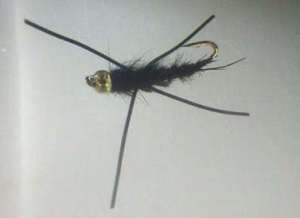
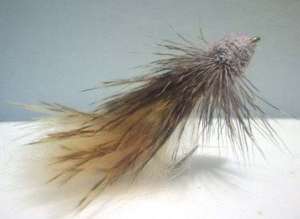
Although not essential, waders or a boat will provide more casting room, better access to the trout, and allow you to fish in deeper water.
Casting: The Tough Part
Although it may seem mystical to an observer, fly casting is an efficient way to get a weightless fly closer to fish. The motion of casting and a few hours spent fly-fishing really appeals to most newcomers who show an interest in the sport. Many find it relaxing and a really great way to connect with nature – which is no different than any other type of fishing.
Long-time fly fisherman, guide, and casting instructor Bruce Tilbrook told me the number one reason why people quit fly-fishing is intimidation. Years ago, it was snobby fly anglers not wanting to spend the time teaching newcomers the basic techniques to help them succeed, making it an overwhelming task to learn and master. These days, the magnitude of gadgets seen dangling from a geared-up fly anglers vest can seem daunting. Bruce also mentioned that casting can be tough to learn for some people, but it’s a simple “ten” and “two” o’clock timing, and this concept is taught year around throughout several fishing clubs, schools, and outfitter retail stores like Cabela’s – it should no longer be a barrier to getting into fly-fishing.
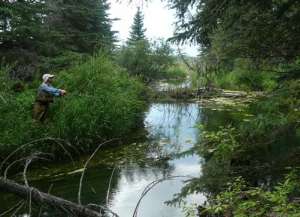
Keep it Simple
Start simple when learning to fly-fish in an environment that will ensure a positive experience. Casting long distances isn’t even necessary to begin fly-fishing, in fact casting any distance isn’t required at all. There’s an old famous saying in the flyfishing world, “learn how to fly cast well over a short distance, rather than poorly over a long distance.
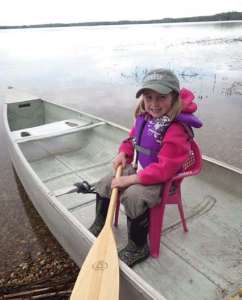
Try Trolling
Trolling removes casting altogether for beginners. Trolling a wet fly (nymphs, streamers, and leeches) around any of Alberta’s 250 stocked trout lakes is a great technique to familiarize yourself with the gear mentioned above. Wet flies are tied with weighted material making them sink and are therefore fished underneath the water’s surface targeting large fish lurking for a meal. Simply drop the fly into the water, allow it to start sinking, strip some line off the reel and move away from the fly.


By floating on the water, if you see structures like debris or natural vegetation providing cover (above or below the water surface) and drop-offs along the shorelines or pinch points between bays, you’ll have plenty of room to practice casting in and around the structure. If you get frustrated or tired, simply troll in and out of the structure by doing ’S’ pattern turns. Bruce’s favorite flies to use in Alberta’s stocked trout lakes are: egg-sucking leeches, wooly-buggers, bead-headed pheasant tail nymphs, back-swimmers, doc spratleys, and adams (in case the trout are rising).
Fly-Fishing For All Ages
Anyone can start fly-fishing, young or old, fishermen or not, experienced or not. Even small children aged four or five can handle a fly rod and reel. This past summer I introduced my daughter to fly-fishing by rigging up a seven-foot, four-weight rod with matching floating line and a nine-foot leader with an egg-sucking leech tied on the end. She didn’t have to cast at all – I simply placed her in the canoe near the back with her seat turned ninety degrees. She sat holding the rod straight in front of her and I taught her how to strip line and hold the rod out to the side a foot off the water.
Rookie Success
The motion of the canoe forced the weighted line out behind us. She didn’t have to work the rod or line at all – she simply held the fly rod trolling. Each paddle stroke created enough momentum to realistically mimic a leech swimming at the other end of the line. Within no time, she had several hits and she held the line against the rod as she set the hook. Once she hooked a fish, she tried to crank the reel, but most fly reels have no gears whatsoever, meaning the line retrieved is a one-to-one ratio with the amount of cranking you have to do.
By the time she reeled the rainbow trout in, her little fingers and hand were tired. Because I was seated near her, I helped hold the rod as the fish pumped, turned, and fought for its life. In the end, it wasn’t all that different from trolling a Rapala, but she had more hits than her brother, who was trolling just that. Truthfully, you could troll a streamer pattern off monofilament line from a spinning rod with some split shot clamped on the leader. But having rookies use fly-fishing equipment in a simple setting is a good way to introduce them to this style of fishing. Making short casts near structures and around drop-offs are ideal places to start fly casting, as opposed to streams lined with steep banks and dead-fall. Quite often, cutthroat trout are easy to fool – a great fish for beginners.
Dry Fly-Fishing
For those who want to try their hand at dry fly-fishing on streams, pick a freestone river like the North Ram when conditions are good. The small holding pools will provide ample casting room without interference and a chance to hook several cutthroat trout. Conditions are ideal when water levels are low and have clear visibility. Small stocked trout ponds, like the Lions campgrounds and municipal park grounds, usually have plenty of back casting room for beginners and fish can be found cruising the edges of the ponds at dusk. Ponds that have aerators are best and will often ensure good fishing come spring, so seek those out.
In the end, fishing is fishing – a way to connect with nature away from our busy lives. Fishing offers the opportunity to enjoy and learn about nature, relax, spend time with friends and family and solve problems, even if only for a few hours, with nothing but the splashing of trout to disturb your thoughts. However, if you do get hooked specifically on fly-fishing it won’t be because of the primitive, exhilarating battle between human and fish. It won’t be the great outdoors and the chance to get back to nature. It’ll be the bugs and a deeper understanding of fish and their behavior – but that is for another time.
_____
Ready to learn more? Check out 8 Essential Fly-FIshing Knots (And How To Tie Them)
Per our affiliate disclosure, we may earn revenue from the products available on this page. To learn more about how we test gear, click here.






